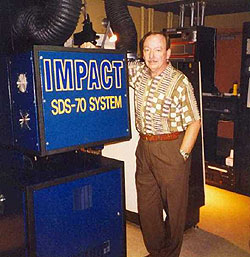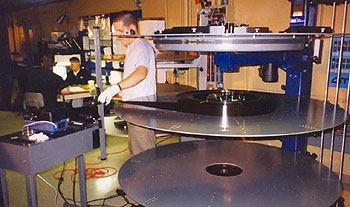|

“Almost like a real web
site”
|
IN7OMM.COM
• Search |
Contact
• News |
e-News |
• Rumour Mill |
Stories
• Foreign Language
• in70mm.com auf Deutsch
WHAT'S ON IN 7OMM?
7OMM FESTIVAL
• Todd-AO Festival
• KRRR! 7OMM Seminar
• GIFF 70, Gentofte
• Oslo 7OMM Festival
• Widescreen Weekend
TODD-AO
• Premiere |
Films
• People |
Equipment
• Library |
Cinemas
• Todd-AO Projector
• Distortion Correcting
PANAVISION
• Ultra Panavision
70
• Super Panavision
70
|
 |
|
VISION, SCOPE & RAMA
1926
Natural Vision
1929 Grandeur
1930 Magnifilm
1930 Realife
1930 Vitascope
1952 Cinerama
1953
CinemaScope
1955 Todd-AO
1955 Circle Vision
360
1956
CinemaScope 55
1957 Ultra
Panavision 70
1958 Cinemiracle
1958 Kinopanorama
1959 Super
Panavision 70
1959 Super Technirama 70
1960 Smell-O-Vision
1961 Sovscope
70
1962
Cinerama 360
1962 MCS-70
1963 70mm Blow Up
1963 Circarama
1963 Circlorama
1966 Dimension 150
1966
Stereo-70
1967 DEFA 70
1967 Pik-A-Movie
1970 IMAX / Omnimax
1974 Cinema
180
1974 SENSURROUND
1976 Dolby Stereo
1984 Showscan
1984 Swissorama
1986 iWERKS
1989 ARRI 765
1990 CDS
1994 DTS / Datasat
2001
Super Dimension 70
2018 Magellan 65
•
Various Large format
| 70mm to 3-strip |
3-strip to 70mm |
Specialty Large Format |
Special Effects in 65mm |
ARC-120 |
Super Dimension 70
| Early Large Format
• 7OMM Premiere in
Chronological Order
7OMM FILM & CINEMA
• Australia |
Brazil
• Canada |
Denmark
• England |
France
• Germany |
Iran
• Mexico |
Norway
• Sweden |
Turkey
• USA
LIBRARY
• 7OMM Projectors
• People |
Eulogy
• 65mm/70mm Workshop
• The 7OMM Newsletter
• Back issue |
PDF
• Academy of the WSW
7OMM NEWS
• 2026 | 2025 | 2024
• 2023 |
2022 |
2021
• 2020 |
2019 |
2018
• 2017 |
2016 |
2015
• 2014 |
2013 |
2012
• 2011 |
2010 | 2009
• 2008 | 2007 |
2006
• 2005 | 2004 |
2003
• 2002 |
2001 |
2000
• 1999 |
1998 |
1997
• 1996 |
1995 |
1994
|
|
in70mm.com Mission:
• To record the history of the large format movies and the 70mm cinemas
as remembered by the people who worked with the films. Both during
making and during running the films in projection rooms and as the
audience, looking at the curved screen.
•
in70mm.com, a unique internet based magazine, with articles about 70mm
cinemas, 70mm people, 70mm films, 70mm sound, 70mm film credits, 70mm
history and 70mm technology. Readers and fans of 70mm are always welcome
to contribute.
•
Disclaimer |
Updates
• Support us
• Testimonials
• Table of Content
|
| |
| |
Extracts and longer
parts of in70mm.com may be reprinted with the written permission from
the editor.
Copyright © 1800 - 2070. All rights reserved.
Visit biografmuseet.dk about Danish cinemas

|
| |
Super Dimension 70
New
70mm Process Demonstrated
|
This article first appeared in
..in 70mm
The 70mm Newsletter |
|
Written by:
Robert Weisgerber, Super Dimension
70 |
Issue 63 - March 2001 |
|
 Robert
Weisgerber next to the 70mm projector Robert
Weisgerber next to the 70mm projector
A
new company, known as "Super Dimension 70", has recently been
creating some attention for itself in the Hollywood community, with a
"new, improved" 70mm presentation process. In a nutshell, what
they are proposing (and demonstrating) is 70mm film, with the usual aspect
ratio, run at 48 frames per second.
The
system uses a custom designed projector, the key feature of which is a pair
of two intermittent movements, one at the top and one at the bottom of the
projection gate. They are precisely aligned and synchronized, and help each
other move the film through the gate at the necessary increased speed.
They
have made a demonstration film, similar in execution to the
"Cinespace
70" demonstration film, introduced and narrated by American television
newsman Walter Cronkite (the way Lowell Thomas introduced Cinerama many
years ago.) It features samples
of scenic shots, including aerial (helicopter) views over typically
impressive western vistas. The system is presently installed at the
"Harmony Gold" theatre (a pre-view
and screening theatre) in Los Angeles, where it is being demonstrated
occasionally to interested parties. They hope to persuade someone into
producing a new feature in the process.
This
is the IMPACT, SDS-70 projector and platter that holds 32,000 feet of 70mm
for 2hr and 20min. of running time at 48fps. The Digitally controlled
transport insures pinregistered picture stability while exhibiting each
frame twice for 96 refresh displays totally eliminating flicker.
A
Digital 8 track uncompressed sound repoducer follows in sync with the film
via time code view and screening theatre) in Los Angeles, where it is being
demonstrated occasionally to interested parties. They hope to persuade
someone into producing a new feature in the process.
(This
process is somewhat similar to the 35mm/48fps "Maxivision"
proposal, but of course this is using 70mm film...)
|
Further in 70mm reading:
SDS 70 DMX Process
DMX digital presentation
Super Dimensional
Xperience
Internet link:
Super Dimension
70
Super
Vista Corporation
245 East 93rd Street, Suite 32 A
New York
NY 10128
USA
+1
212 369 5035
+1 212 348 4136 (fax)
Los
Angeles +1 818 789 1065
|
The
Press Release from SDS-70 accompanys
|
|
 "Redefining
the Movie Going Experience" "Redefining
the Movie Going Experience"
Super
Vista Corporation licenses and supplies its proprietary technology Super
Dimension-70 (SDS-70) system, which presents to the film entertainment
industry a revolutionary new leading edge motion picture process.
The
company owns patent rights to its breakthrough motion picture system for the
production and exhibition of feature length films. The SDS-70 process was
conceived and developed by Robert C Weisgerber, President of Super Vista
Corporation. The patents are for a method that imparts both high-impact
cinematic and conventional images on the same strip of film. The result
immerses the audience as if they are part of the movie drawing them into the
depths of the screen. This technology allows filmmakers the opportunity to
take their creative vision to a new plateau.
The
recent success of both "Everest" ($100 million gross) and Disney's
"Fantasia/2000" in IMAX ($60 million in 120 days), proves that
large format films can draw huge audiences willing to pay extra to see and
experience an event movie.
Super
Dimension-70 now for the first time makes available to filmmakers the
ability to enter this lucrative market with full-length, large format event
motion pictures.
Super
Vista Corporation is a full service organization providing the film industry
the tools to create, produce, post-produce and exhibit SDS-70 feature length
motion pictures. The company licenses the SDS-70 process from photographic
to projection equipment and also provides full service design, installation
and maintenance of the SDS-70 Impact theater technology. Super Vista Corporation has agreements
with major cinema suppliers for key components of the SDS-70 system.
|
|
SDS-70
Preview Theatre Specifications
|
|
 Picture:
Projector: Impact, SDS-70 System. Screen: 23'x47' Ultramatte screen. Lens:
92mm. Lamp: 7000 Watt Picture:
Projector: Impact, SDS-70 System. Screen: 23'x47' Ultramatte screen. Lens:
92mm. Lamp: 7000 Watt
Screen
brightness: 35 Foot-Lamberts
Sound:
Reproducer: Double System Digital Hard drive. Sound Synchronization: Time
Code Referenced
Channels:
8 channel uncompressed digital.
Illustration
below (from a Showscan brochure) shows how an SDS theatre looks like.
Theatres are more or less the same.
Projector
built by STRONG. Lens by Isco. Demo SDS film narrated by Walter Cronkite.
|
|
SDS-70
System
|
|
|
*
Super Dimension-70 (SDS-70) is a patented and trademarked process employing
advanced film based 70mm technology.
*
SDS-70 projects film at 48 frames per second. This frame rate closely
replicates the way we see real life. When projected, each frame is presented
twice, resulting in an exhibition display of 96 images per second. For films
shown in this manner there is no projection flicker at any illumination
level.
*
The intensified sense of reality produced by SDS-70 allows the audience to
believe that the screen has disappeared and the viewer is drawn into the
picture.
*
SDS-70 image quality surpasses that of all prior theatrical film systems.
*
SDS-70 presentations deliver high impact, immersively stunning images that
are unrivalled in commercial cinema exhibition.
*
A feature film director employing SDS-70 can tell a cinematic story without
compromise.
*
When CGI is employed the effects are enhanced and become part of the
immersive experience.
*
Aside from requiring additional 65/70mm film stock because more frames are
exposed, production costs are basically on par with conventional filmmaking.
*
Conventional 35mm, 24 frame prints can be extracted from the SDS-70
laboratory master making very wide distribution possible. Films produced in
SDS-70 yield high-resolution pictures when converted to standard film
formats.
*
No costly theater construction is required to facilitate SDS-70.
*
The SDS-70 projection system can fit into any normal size projection booth.
*
Standard 35mm and 70mm 24 frame motion pictures can be re-purposed for
SDS-70 projection allowing for superior image and higher illumination
levels.
*
Previously released feature films can be converted to the SDS-70 exhibition
system renewing their theatrical exhibition life.
*
SDS-70 displays more than double the image information presented with
conventional films and almost six times the image area of the standard 35mm
wide screen frame.
*
The patented SDS-70 Impact Projector incorporates a "rock steady"
movement. There is no perceivable jump or weave on the screen. In addition,
no parts of the projection system come in contact with the image area of the
film, substantially reducing dirt and scratch artifacts.
*
SDS-70 screen quality is significantly superior to digital cinema. SDS-70
prints have in excess of 22 million pixels per frame compared to only 1.3
million pixels in current DLP cinema.
*
Projection lamps of up to 10kW can be used. Screen illumination of more than
20 Foot-Lamberts can be achieved without projection flicker.
*
The projection technology is best suited for screen sizes between 50ft. and
80ft. Curved or flat screens can be used with a moderate radius being the
preference. However, it is recommended that the screens be as large as the
theatre can accommodate.
*
Estar prints can run for more than 2000 passes without any discernable wear
*
The SDS-70 platter system provides for more than 2 hrs. and 20 min. of
uninterrupted screening. The platter can accommodate two complete SDS-70
feature films.
*
Eight channel uncompressed digital sound is incorporated into the SDS-70
presentation through the use of a double system hard drive reproducer.
*
Standard definition or digital high definition video transfers can be made
from SDS-70 film masters.
|
|
|
|
Go: back
- top - back issues
Updated
21-01-24 |
|
|
 "Redefining
the Movie Going Experience"
"Redefining
the Movie Going Experience" Picture:
Projector: Impact, SDS-70 System. Screen: 23'x47' Ultramatte screen. Lens:
92mm. Lamp: 7000 Watt
Picture:
Projector: Impact, SDS-70 System. Screen: 23'x47' Ultramatte screen. Lens:
92mm. Lamp: 7000 Watt
 Robert
Weisgerber next to the 70mm projector
Robert
Weisgerber next to the 70mm projector